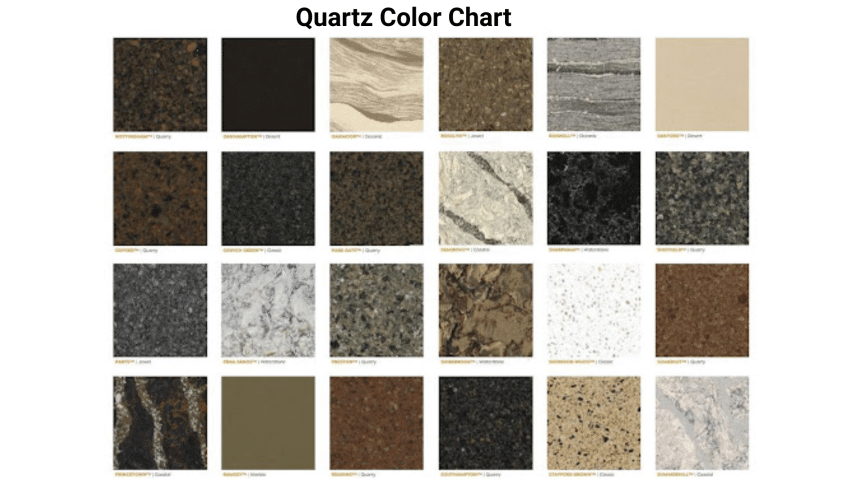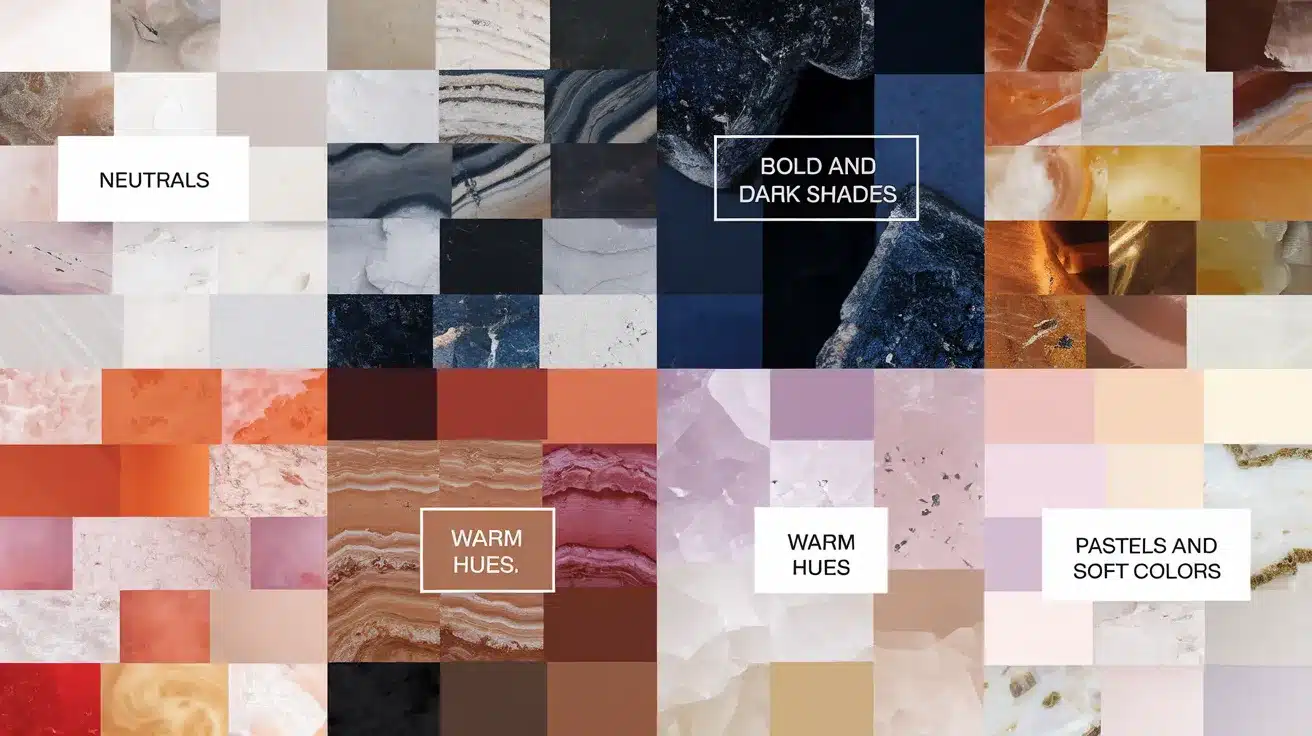Finding the perfect quartz color for your home project can feel overwhelming. With hundreds of options across manufacturers and seemingly subtle differences between shades, it’s easy to get lost in a sea of samples without a clear direction.
I know this frustration firsthand, which is why a quartz color chart becomes your best tool for making confident decisions.
Having guided countless clients through this process, I’ve seen how the right color selection changes ordinary countertops into stunning focal points.
In this article, I’ll show you exactly how to use quartz color charts to narrow down options that match your vision, identify undertones that complement your space, and avoid common selection mistakes that lead to buyer’s remorse.
Let’s simplify your selection process and help you find your perfect match.
How a Quartz Color Chart Simplifies Your Design
- Eliminates guesswork by showing actual colors instead of relying on memory or digital images
- Reveals true patterns and textures that might not be visible in photographs
- Simplifies coordination with existing cabinetry, flooring, and paint colors
- View samples in different lighting conditions for accurate color assessment
- Consider space size when selecting colors (darker colors make spaces feel smaller)
- Think long-term about color choices rather than following short-lived trends
- Reduces decision fatigue and builds confidence in your final selection
- Helps avoid costly mistakes or disappointment after installation
Why Quartz Colors Matter in Interior Design
Color Impact on Room Atmosphere
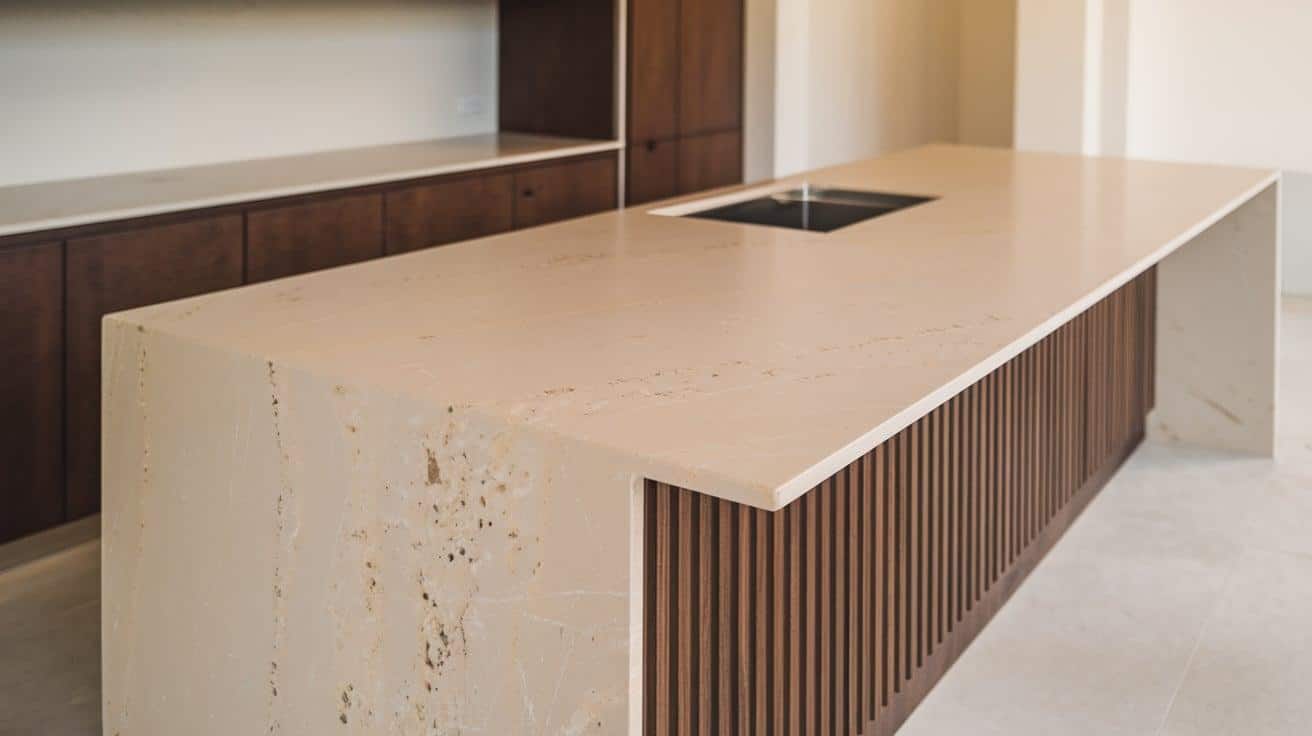
The quartz color you select dramatically shapes how a room feels. Light colors like whites and creams make spaces appear larger and more open, perfect for smaller kitchens or bathrooms.
Darker tones like charcoal or black create depth and sophistication but can make tight spaces feel smaller. Medium tones offer balance and often hide everyday wear better than very light or dark options.
Match Quartz with Existing Decor
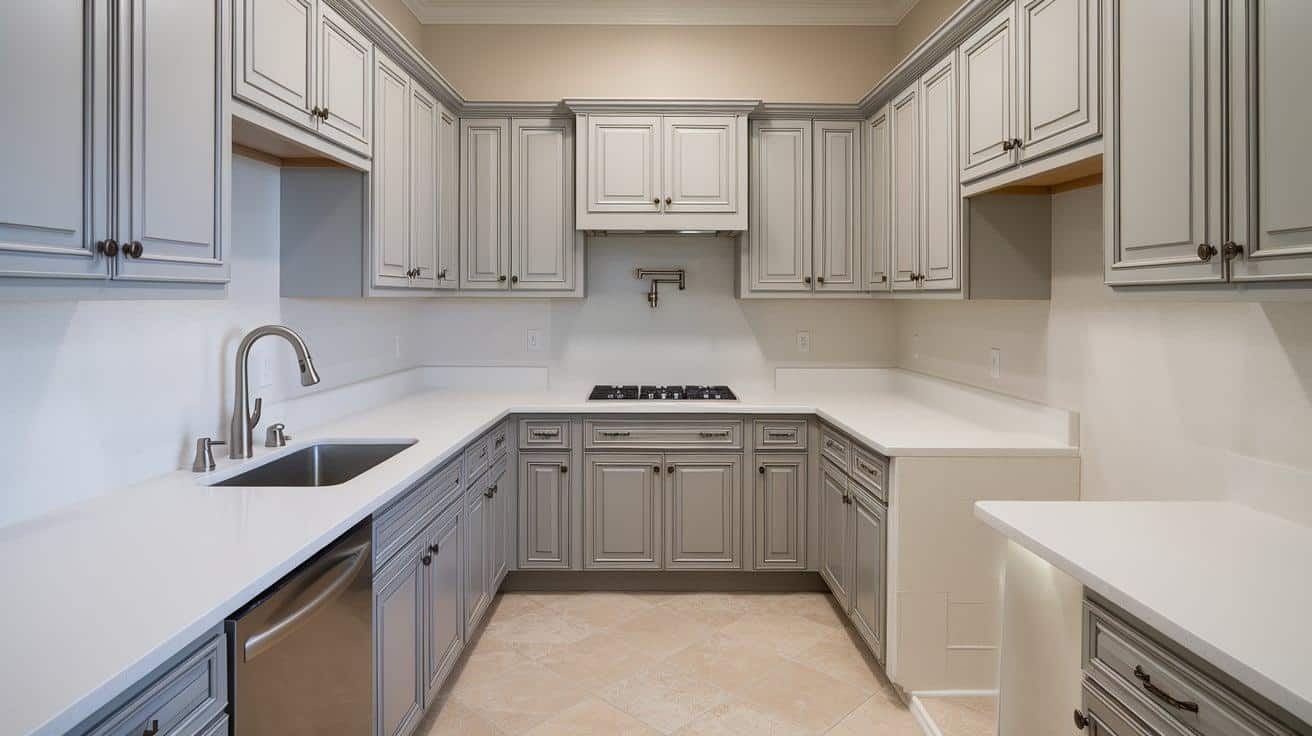
Your quartz doesn’t exist in isolation. It needs to work with your cabinets, flooring, wall color, and fixtures. When selecting quartz, I recommend bringing samples of cabinet materials, paint chips, and flooring pieces.
Pay special attention to undertones. White quartz with yellow undertones might clash with cabinets with cool gray undertones.
Current Trends in Quartz Colors
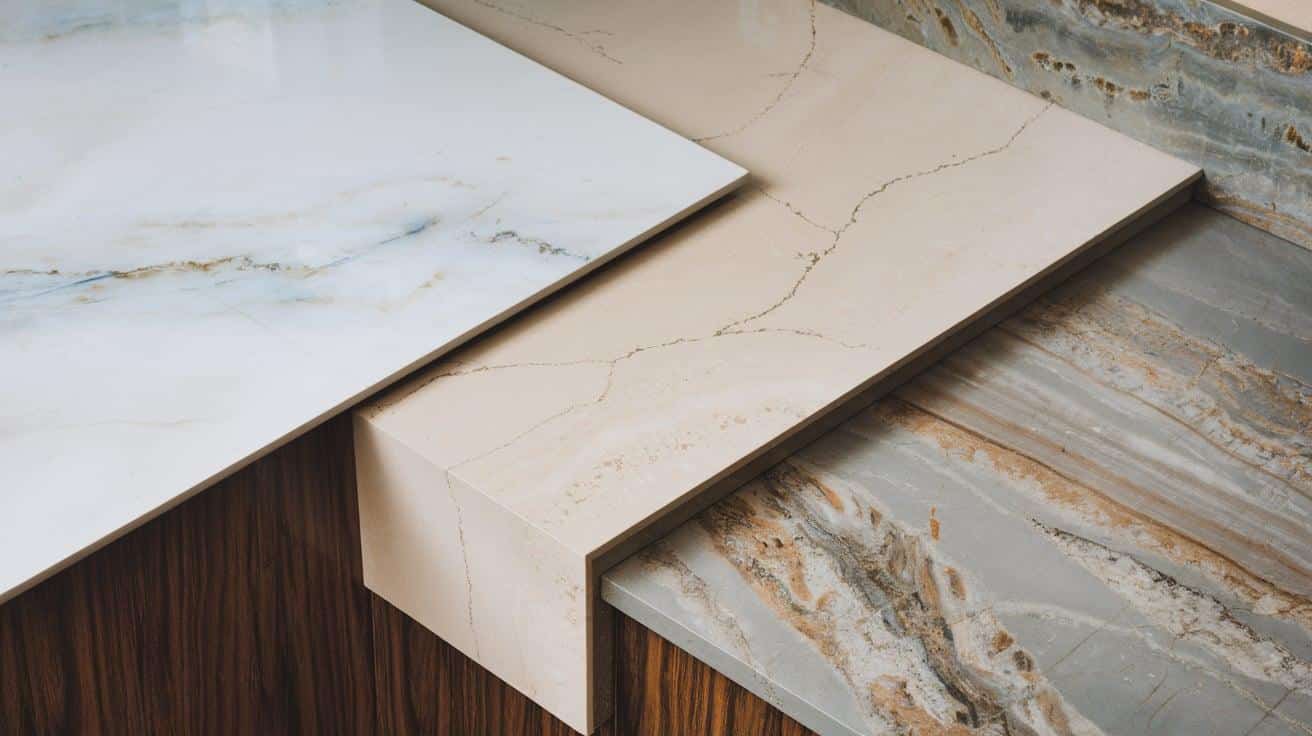
While classic whites remain timeless, I’m seeing more interest in “barely there” colors with subtle movement, soft grays with delicate veining that mimic natural stone without the maintenance concerns.
Earthy neutrals are gaining popularity as people seek warmth and a connection to nature in their homes. Statement colors like navy blue or forest green are appearing in islands or as accents in otherwise neutral kitchens.
Common Quartz Color Families
1. Neutrals
- White, gray, and beige quartz options remain the most popular choices for good reason. These timeless colors work with virtually any design style, from traditional to modern.
- White quartz brightens spaces and makes them feel larger, while light grays offer similar benefits with slightly more forgiveness for everyday messes.
- If you’re unsure about your long-term design plans, neutrals allow you to change surrounding elements without replacing your countertops.
2. Bold and Dark Shades
- Black, deep blue, and charcoal quartz make powerful statements in your space. These rich colors can anchor a room and create a dramatic contrast against light cabinetry.
- Dark quartz often has a sophisticated, luxurious feel that works beautifully in both modern and traditional settings.
- I find these colors particularly effective in larger kitchens or as island accents where they won’t overwhelm the space.
3. Warm Hues
- Earthy tones like brown, tan, and terracotta bring natural warmth to your home. These colors connect indoor spaces with outdoor environments and create a cozy, inviting atmosphere.
- Warm-toned quartz pairs beautifully with wood cabinets and flooring, creating a harmonious look. These colors have seen a resurgence in popularity as more homeowners seek comfort and grounding elements in their designs.
4. Pastels and Soft Colors
- Light pink, soft lavender, and creamy whites offer subtle personality while maintaining a light, airy feel.
- These gentle colors can make spaces feel fresh and unique without becoming overwhelming or trendy. Soft colors work particularly well in bathrooms, powder rooms or as accents in otherwise neutral kitchens.
- They pair beautifully with gold or brass fixtures for a quietly elegant look.
Popular Quartz Colors and Their Uses
| Quartz Color | Best For | Estimated Cost | Description |
|---|---|---|---|
| Calacatta Gold | Luxury kitchens, statement islands, high-end bathrooms | High ($75-120/sq ft installed) | Premium white with gold veining mimics marble, ideal for high-end spaces. |
| Pure White | Modern kitchens, small bathrooms, minimalist spaces | Medium ($55-85/sq ft installed) | Bright, clean, and perfect for airy and open spaces, but requires frequent cleaning. |
| Sparkling Black | Contemporary kitchens, bar areas, powder rooms | Medium-High ($65-95/sq ft installed) | Black with metallic flecks, dramatic and sophisticated, works well in larger spaces. |
| Greige (Gray-Beige) | Transitional kitchens, versatile bathrooms, multi-purpose areas | Medium ($60-85/sq ft installed) | Neutral mix of gray and beige, versatile and hides messes well. |
| Concrete Gray | Industrial designs, modern lofts, commercial spaces | Medium ($55-80/sq ft installed) | Polished concrete look with no porosity, ideal for industrial and commercial spaces. |
Where to Find a Quartz Color Chart and Samples
Best Places to View Quartz Samples
Nothing beats seeing quartz in person before making your final decision. The way colors look online versus in your actual space can be dramatically different due to lighting and surrounding colors.
- Kitchen and Bath Showrooms: These specialized retailers often display large quartz slabs or full kitchen vignettes. You’ll get expert advice and can see how different colors look in actual cabinet and flooring combinations. Most showrooms welcome walk-ins, though scheduling an appointment ensures you’ll get personalized attention.
- Big Box Home Improvement Stores: Retailers like Home Depot and Lowe’s carry major quartz brands like Silestone and Caesarstone. While their sample selection might be more limited than specialty showrooms, they’re convenient and often less intimidating for first-time buyers.
- Manufacturer Websites: Brands like Cambria, Caesarstone, and Silestone offer comprehensive online color galleries with high-quality images. Many also feature room visualizers where you can see how different colors look in various settings. This is a great starting point before visiting showrooms.
How to Order Physical Samples for Comparison
- Manufacturer Direct: Most quartz manufacturers offer free or low-cost sample programs through their websites. Samples typically arrive within a week and are usually 4″x 4″ or smaller. Some premium brands may charge a nominal fee that’s often refundable with a purchase.
- Local Dealers: Your nearest authorized dealer can provide samples of the brands they carry. The advantage here is getting expert guidance on which colors might work best for your project.
- Design Professionals: If you’re working with an interior designer or kitchen planner, they can often order samples for you from their professional accounts, sometimes accessing options not readily available to the public.
- Sample Boards: Some retailers offer sample boards with multiple small chips of different colors. While these won’t show the full pattern, they’re useful for initial color elimination.
Common Mistakes to Avoid When Choosing Quartz Colors
- Misjudging how a color will look in different lighting.
- Ignoring maintenance and durability aspects of specific colors.
- Focusing too much on trendy colors instead of long-term usability.
- Overcomplicating the design with too many contrasting elements.
- Not accounting for space size when selecting colors.
- Failing to consider how colors coordinate with adjacent rooms.
Conclusion
Selecting the right quartz color might seem challenging at first, but with a color chart as your guide, you’ll make choices that improve your space for years to come.
Remember to test samples in your actual environment, consider how different lighting affects appearance, and choose colors that complement your existing elements.
A well-chosen quartz color does more than fill space; it sets the mood, ties design elements together, and creates the foundation for your room’s overall feel. Whether you prefer timeless neutrals, bold statements, or warm earth tones, your selection should reflect both your style and practical needs.
Take these tips to your local showroom, request samples from manufacturers, and test them in your space. Your perfect quartz match is waiting to be found.
Frequently Asked Questions
What Is the Rarest Color of Quartz?
The rarest natural quartz color is red (also called cherry quartz). Other extremely rare varieties include pink rose quartz in crystal form and natural green quartz (prasiolite).
What Is the Most Valuable Quartz?
Amethyst is generally the most valuable natural quartz variety, especially deep purple specimens from Russia, Uruguay, and Zambia.
Which Quartz Is the Most Expensive?
Deep purple amethyst from specific regions like Siberia, Uruguay, and Brazil is typically the most expensive natural quartz.

